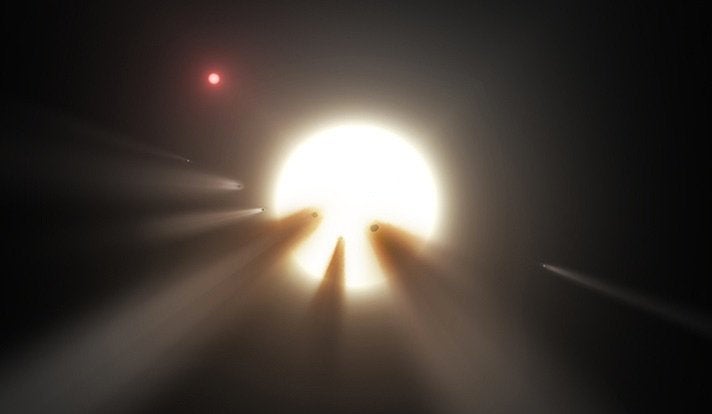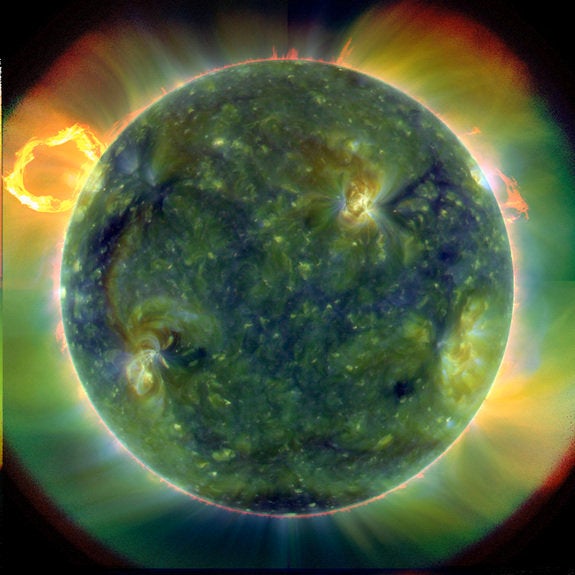
KIC 8462852 has been called the most mysterious star in the universe, and for good reason.
In many ways, the distant sun ― a bit bigger and hotter than our own sun but otherwise pretty similar ― is just another star. But its flickering light is so strange and inexplicable that some people are wondering whether space aliens are involved.
The star’s light dips unpredictably when some unknown object ― estimated by astronomers to be 1,000 times bigger than Earth ― comes between the star and our telescopes. But what exactly is this colossal object?
Scientists have come up with various possibilities, including a cosmic dust cloud, an asteroid belt or even a “swarm” of comets. But another possibility is that the object is some sort of vast structure built around KIC 8462852 by a race of intelligent alien beings.
Talk of “alien megastructures” sounds far-fetched. But even mainstream scientists like Dr. Tabetha Boyajian ― the astronomer whose research put KIC 8462852 in the spotlight late last year ― say it’s a hypothesis that can’t be dismissed out of hand.
To learn more about what some are calling “Tabby’s star,” HuffPost Science posed a series of questions to Boyajian, an assistant professor of astronomy and physics at Louisiana State University. Here, lightly edited, are her answers.

What makes KIC 8462852 so interesting?
As an astronomer, it is very exciting to explore space, test theories and make new discoveries. This star doesn’t fit the mold of any astronomical object we know of today ― stars just don’t do that. This has made us think really hard about what could be happening and what experiments we can do to test them.
What do you think is causing the shifting patterns of light?
There has to be something surrounding the star that is blocking the starlight. Of the many proposed, the “swarm of comets” hypothesis is still the leading one. But invoking such a model is extremely tricky, given the observations we have in hand. At this point, we need to start thinking outside the box and get rid of the unconscious bias we have on what nature can do.
Is it really possible that the flickering light is a sign of advanced alien life?
Evidence of advanced alien life is not at all confirmed by the dips in brightness we observe in KIC 846. That is a “last resort” interpretation to describe what is happening with the star. Even if we exhaust all natural scenarios to explain the observations, this does not qualify as evidence of extraterrestrial life. It just means we have to work harder and continue to study the system.
Some say the light-blocking object could be a Dyson sphere. What’s that?
In 1960, theoretical physicist Freeman Dyson published a paper in the journal Science entitled “Search for Artificial Stellar Sources of Infrared Radiation.” It described the concept of a large-scale artificial structure built by a highly advanced civilization which was perhaps built to harvest more energy from its host star or to provide additional “real estate” for its population to occupy.

Where exactly is the star located? Is it visible to the naked eye?
The star is visible in the (northern hemisphere) summer sky, within the constellation of Cygnus (the Northern Cross). Its visual magnitude is around 12, which means it is far too faint to see with the naked eye. But it is easily visible with a small telescope.
We derived a distance from us to the star of about 450 parsecs, or approximately 1,400 light-years. This means that our observations of the star today are from light emitted 1,400 years ago.
Who discovered the star and its strange light patterns?
The star was spotted by citizen scientists working with the Planet Hunters program. Planet Hunters volunteers look through data from the NASA Kepler space telescope to look for signals indicating that a planet is “transiting” (crossing in front of) a star. While sifting through four years of data on over 150,000 stars, volunteers spotted this star and started talking about it on the project’s discussion forum.
The first small dip in light was identified in 2011. The following year a large 15-percent dip was identified.
How did the star get its nickname?
My team refers to it as “WTF” after the title of our paper, “Where’s the Flux.” The star has also become known as the “alien megastructure star” and even by some folks as “LGM2, a reference to LGM1, a term coined in the 1960s for a pulsar whose signal was so regular that astronomers joked it might have come from “little green men.”
But as the story goes, my colleague Jason Wright was talking to a reporter about the star. Instead of calling it by its catalog name, KIC 8462852, he referred to it as “Tabby’s Star.” When this came out in print, it stuck.
What is being done to determine what’s going on with the star?
There are several projects to study the star, both planned and ongoing. That’s great because we need more data. I think the most remarkable contribution is that the American Association of Variable Star Observers sent out an alert for amateurs to monitor this star’s brightness, and there has been an overwhelming response.
Is this the only star to show the weird light patterns?
There are known “dippers,” and some have light patterns somewhat similar to this star (the objects I am referring to were not discovered in the main Kepler mission like our star). However, this star is strange because it shows no other signs of activity which are expected and observed in other dippers. The biggest inconsistency is the lack of an excess of infrared light that our star has: The typical dipper has some sort of debris disk around it, which glows bright at these infrared wavelengths.
Finally, the way in which the star has dimmed over the course of many years appears to be exclusive to this star, which is very strange because stars should not do that.
When will we get the answers we’re looking for?
We need to catch the star when it dips again to learn more about what is happening. But we don’t know when the next dip will occur. So it’s a waiting game. If/when we catch the star dipping again, there is the possibility that we will not be able to immediately interpret the data to get a solid answer. That said, it is rarely the case that there is an “on-off” experiment in science. Rather, once we learn something, there are 10 more questions that follow. This is the burden of knowledge. :)

